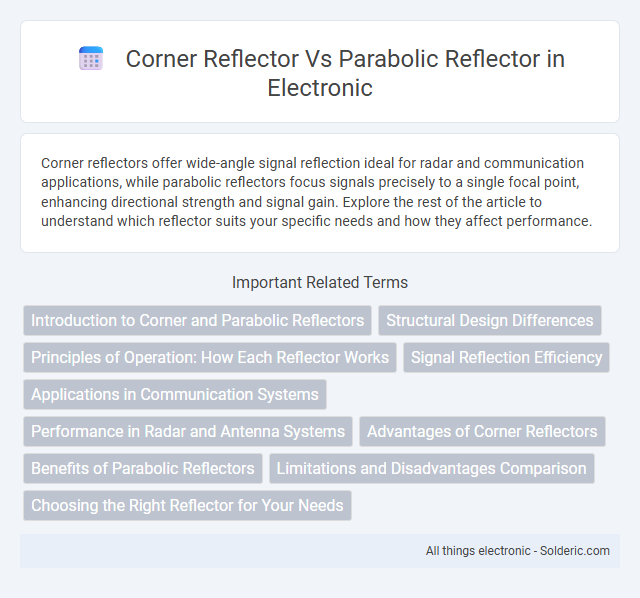Corner reflectors offer wide-angle signal reflection ideal for radar and communication applications, while parabolic reflectors focus signals precisely to a single focal point, enhancing directional strength and signal gain. Explore the rest of the article to understand which reflector suits your specific needs and how they affect performance.
Comparison Table
| Feature | Corner Reflector | Parabolic Reflector |
|---|---|---|
| Shape | Three mutually perpendicular flat surfaces | Parabolic curved surface |
| Function | Reflects waves back to the source | Focuses waves to a single focal point |
| Applications | Radar targets, antennas, retroreflectors | Satellite dishes, radio telescopes, solar concentrators |
| Gain | Moderate gain, dependent on size | High gain with precise shaping |
| Beamwidth | Wide beamwidth | Narrow beamwidth |
| Polarization | Maintains polarization of incident wave | May alter polarization depending on feed |
| Size and Weight | Simple, compact design | Generally larger, requires precise construction |
| Cost | Lower cost, easier to manufacture | Higher cost due to complexity and materials |
Introduction to Corner and Parabolic Reflectors
Corner reflectors consist of three mutually perpendicular reflective surfaces that return incoming waves directly back to the source, making them highly effective for radar applications and signal reflection. Parabolic reflectors feature a curved, parabolic shape that focuses incoming waves to a single focal point, enhancing signal strength in antennas and telescopes. Both types optimize wave reflection but serve different purposes based on directional focus and geometric design.
Structural Design Differences
Corner reflectors consist of three mutually perpendicular flat surfaces arranged to reflect incoming waves back toward their source, creating a compact, angular structure ideal for radar and communication applications. Parabolic reflectors feature a curved, parabolic surface that focuses incoming waves to a single focal point, maximizing signal concentration and gain. The structural design of corner reflectors emphasizes simple geometric configuration with predictable reflection paths, while parabolic reflectors rely on precise curvature to achieve optimal wave focusing.
Principles of Operation: How Each Reflector Works
A corner reflector operates by reflecting incoming waves off three mutually perpendicular surfaces, causing the signals to bounce back toward the source with minimal scattering, enhancing signal strength and detection accuracy. Parabolic reflectors use a parabolic-shaped surface to focus incoming waves onto a single focal point, concentrating energy to increase signal intensity and directionality. Your choice depends on whether you need broad-angle signal return with corner reflectors or high-gain, focused signals from parabolic reflectors.
Signal Reflection Efficiency
Corner reflectors offer high signal reflection efficiency by reflecting waves back to their source with minimal dispersion, making them ideal for radar and communication applications requiring precise signal return. Parabolic reflectors concentrate signals to a single focal point, maximizing signal strength and directivity for transmission or reception in satellite dishes and antennas. Your choice depends on whether you prioritize broad signal capture with strong return (corner reflector) or focused signal concentration and amplification (parabolic reflector).
Applications in Communication Systems
Corner reflectors are widely used in radar and radio communication systems for signal enhancement and target detection due to their ability to reflect signals back toward the source with minimal loss. Parabolic reflectors focus electromagnetic waves into a narrow beam, making them ideal for satellite communication, point-to-point microwave links, and radio telescopes where directional signal transmission and reception are critical. Your choice between these reflectors depends on the need for omnidirectional signal reflection versus highly directional signal focusing in communication applications.
Performance in Radar and Antenna Systems
Corner reflectors and parabolic reflectors both enhance radar and antenna system performance by focusing electromagnetic waves but differ significantly in application effectiveness. Parabolic reflectors provide high gain and precise directionality, ideal for long-range radar detection and communication by concentrating signals into a narrow beam. Your choice depends on system requirements; corner reflectors offer simple, wide-angle backscatter useful for radar calibration, while parabolic reflectors excel in maximizing signal strength and resolution.
Advantages of Corner Reflectors
Corner reflectors offer superior signal reflection efficiency by directing electromagnetic waves back towards the source with minimal scattering, enhancing radar and communication system performance. Their simple geometric design provides broadband operation and durability, making them ideal for various environmental conditions without complex maintenance. Unlike parabolic reflectors, corner reflectors maintain consistent reflection regardless of the incident wave angle, ensuring reliable signal return in dynamic scenarios.
Benefits of Parabolic Reflectors
Parabolic reflectors offer superior signal focusing capabilities by directing waves to a single focal point, enhancing signal strength and clarity. Their design enables higher gain and improved efficiency in communication systems compared to corner reflectors. You benefit from a more precise and powerful signal reception or transmission, ideal for satellite dishes and radar applications.
Limitations and Disadvantages Comparison
Corner reflectors suffer from bulkiness and limited directionality, making them less suitable for compact or highly directional applications. Parabolic reflectors face challenges like precise alignment requirements and sensitivity to surface imperfections, which can degrade signal quality. Both reflectors have trade-offs in size and efficiency, with corner reflectors offering broader coverage but lower gain, whereas parabolic reflectors provide higher gain but narrower beamwidth.
Choosing the Right Reflector for Your Needs
Corner reflectors offer wide-angle signal reflection and are ideal for applications requiring consistent coverage in multiple directions, such as radar and wireless communication systems. Parabolic reflectors focus signals into a narrow beam, providing higher gain and longer range, making them suitable for point-to-point communication and satellite dishes. Selecting the appropriate reflector depends on whether broad coverage or focused signal strength best meets your specific performance requirements.
corner reflector vs parabolic reflector Infographic

 solderic.com
solderic.com